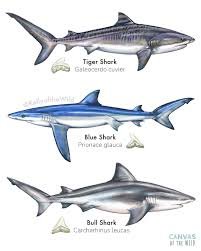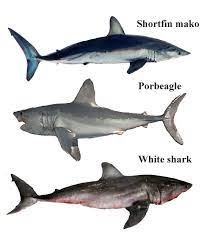Mako vs. Blue Shark
Don’t make us choose! We love them both equally, but just they do have incredible differences despite being highly migratory deep-dwelling sharks.
Etyomology and Classification
The Blue Shark’s name is pretty self-explanatory, given by that gorgeous shade of opalescent blue. Both species, like many sharks, are countershaded, with lighter colored undersides giving them camouflage when viewed from either above or below. The Blue Shark’s latin name Prionace Glauca further alludes to its coloration, with Prionace meaning “pointed saw” and glauca meaning “blue.” Blue Sharks belong to the requiem shark classification along with most sharky sharks such as Silky Sharks, Tiger Sharks, Bull Sharks, and many others.
Requiem Sharks
Mackerel Sharks
The word Mako on the other hand, comes from the language of the Maori people meaning shark or shark tooth. The Shortfin Mako’s latin name Isurus oxyrinchus speaks to its shape, meaning “the same tail” and “pointy snout.” Makos are Mackerel Sharks alongside Great White Sharks, Salmon Sharks and Porbeagles.
Range and Habitat
Both sharks are found in temperate waters worldwide, with Blue Sharks diving a bit deeper to a maximum of 350 meters, whereas Makos max out around 150 meters. Blue Sharks can be found on every continent, as far north as Norway and as far South as Chile. Makos, despite being one of very few warm-blooded sharks, are rarely found in water temperatures cooler than 16 C/61 F. They are the most common shark seen around New Zealand, hence their Maori namesake.
Range of Shortfin Mako
Range of Blue Shark
Favorite Foods
The deeper diving Blue Sharks love squid! Cephlapods are their most important food source, though they will also pursue bony fish such as mackeral and sardines. Ever notice how the Blues tend to love the torpedo on our shark trips? Its full of these oily delights!
Makos have a broader palette, one of their favorite foods is Swordfish as well as tuna, cephlapods, turtles, smaller cetaceans, and ever sea birds! We’ve witnessed many attempted sneak attacks on gulls and shearwaters paddling around the surface on our shark trips!
Reproduction
Shortfin Makos are ovoviviparous, meaning embryos develop inside eggs in the uterus of the female before being born live. The embryos feed on unfertilized eggs over a 15-18 month gestation period. One female can birth up to 18 baby sharks, each one measuring around 70cm in length! It’s no wonder the females will then rest 18 months before mating again.
Blue Sharks are viviparous, meaning the mother supplies nutrients to the embryos and they are born live, between 4 to 135 shark pups per litter! Blue Shark females gestate for a much more reasonable 9-12 months. They give birth in coastal regions in designated nurseries for the juveniles to develop independently out of relative danger. It is believed that the females will return to the same areas to give birth year after year.
Intelligence
Makos boast one of the largest brain-to-body ratios of all shark species. Their warm-blood also gives their big brains the advantage of maintaining heat and energy, so they can quite simply learn and adapt more easily. They depend less on their electromagnetic reception than other sharks and more on sight, smell and hearing, giving them the unique skill to perceive and determine what is and is not prey more readily.
Blue Sharks on the other hand love their ampullae of Lorenzi, the electromagnetic sensory organ that sharks have on their snouts and connected to their lateral lines. They bump into everything just to see what it is! The can also use this super sense to aid in navigation, detecting the Earth’s geomagnetic fields to guide their way on their impressive migrations.
So there you have it, you can decide for yourself which is your favorite! We are happy to share the water with these exception elasmobranchs and can’t wait for more fun this shark season!













